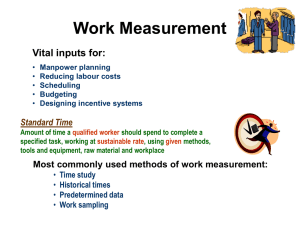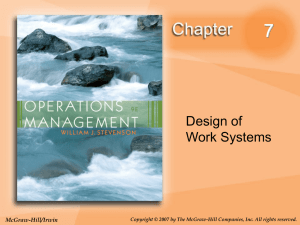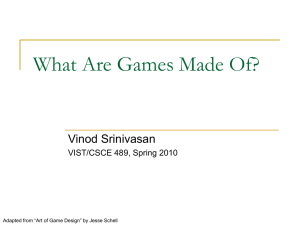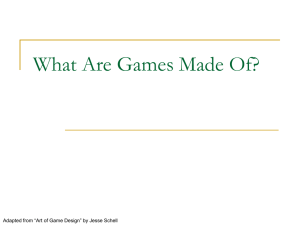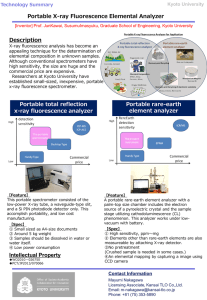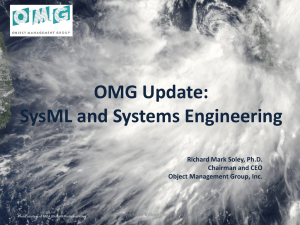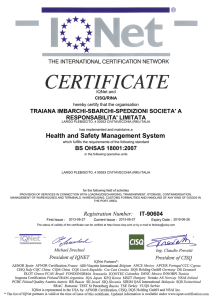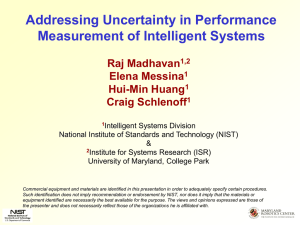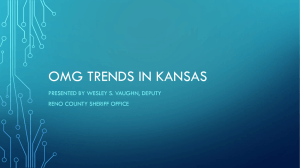Enterprise Architecture 2010: Where Enterprise Architecture
advertisement
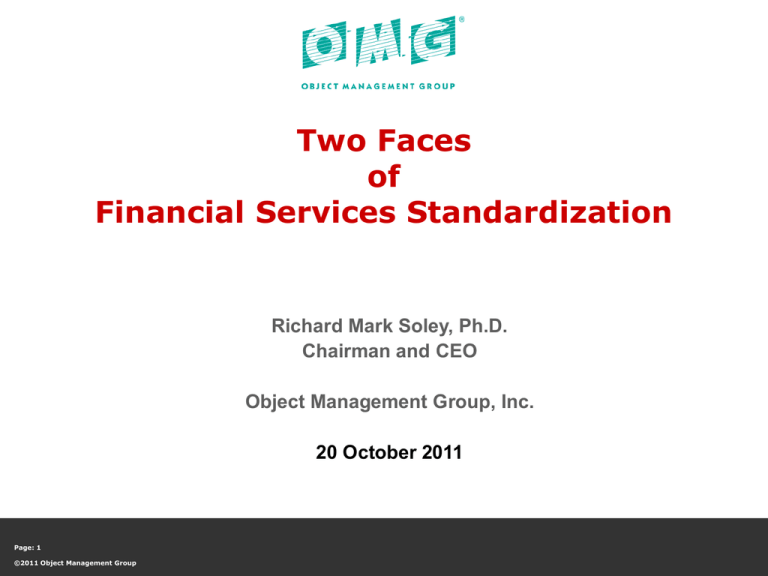
Two Faces of Financial Services Standardization Richard Mark Soley, Ph.D. Chairman and CEO Object Management Group, Inc. 20 October 2011 Page: 1 ©2011 Object Management Group A Story from My Hometown • Great Baltimore Fire of 1904 • Response from Philadelphia, Washington, New York, Virginia, Atlantic City… hundreds of firefighters • Burned for two days, 60 hectares • Why? Elemental Links ©2011 Object Management Group - Page: 2 Standards Are Important • Sometimes they have life-or-death consequences • Successful standards start, maintain and build ecosystems & businesses • Standards are product differentiators: – Marks of quality – Expertise (certification, validation) – Interoperability, Portability & Reuse Elemental Links ©2011 Object Management Group - Page: 3 Integration is Hard Executive decisions, mergers & acquisitions have a way of surprising us… Elemental Links ©2011 Object Management Group - Page: 4 One Standard? • No…but the cost of adaptation must be low. Elemental Links ©2011 Object Management Group - Page: 5 OMG’s Mission • Develop an architecture, using appropriate technology, for modeling & distributed application integration, guaranteeing: – reusability of components – interoperability & portability – basis in commercially available software • Specifications freely available • Implementations exist • Member-controlled not-for-profit Elemental Links ©2011 Object Management Group - Page: 6 Who Are OMG? Adaptive FICO Microsoft OIS Atego Firestar Software MITRE Oracle Boeing Fujitsu PrismTech CA Technologies HCL Model Driven Solutions Citigroup Hewlett Packard Cognizant Hitachi CSC HSBC EADS IBM Eclipse Foundation Lockheed Martin EDS Mayo Clinic National Archives NEC NIST No Magic NTT DoCoMo Northrop Grumman OASIS Elemental Links ©2011 Object Management Group - Page: 7 SAP SWIFT TCS THALES Unisys Wells Fargo W3C You Can’t Do it Alone Elemental Links ©2011 Object Management Group - Page: 8 OMG & Modeling • Best known for key standards in modeling languages and middleware: – – – – – – – – – UML (broad software & systems) SysML (systems engineering) SoaML (service-oriented architectures) BPMN (business processes) CWM (data warehouses) MOF (modeling languages) UPDM (enterprise architectures) CORBA (distributed object-oriented middleware) DDS (real-time publish & subscribe middleware) Elemental Links ©2011 Object Management Group - Page: 9 OMG’s Focus • Three key “infrastructure” standards foci: – Modeling – Middleware – Real-time & other specialized systems • More than 20 “vertical market” foci: – – – – Healthcare Financial services Robotics Etc. • Focused working groups – Business Architecture – Cloud Computing • All in a common context Elemental Links ©2011 Object Management Group - Page: 10 21st Century Enterprise: Globalization Elemental Links ©2011 Object Management Group - Page: 11 21st Century Enterprise: Connectedness Elemental Links ©2011 Object Management Group - Page: 12 21st Century Enterprise: Digital Markets & Value Chains Elemental Links ©2011 Object Management Group - Page: 13 21st Century Enterprise: Continuous Innovation Elemental Links ©2011 Object Management Group - Page: 14 21st Century Enterprise: Change Creation & Adaptation "If you don't like change, you're going to like irrelevance even less.” - General Eric Shinseki, Chief of Staff, US Army. Elemental Links ©2011 Object Management Group - Page: 15 21st Century Enterprise = Complexity Elemental Links ©2011 Object Management Group - Page: 16 The Enterprise Architecture Mission Create an Environment for: That Embraces: And Manages: Elemental Links ©2011 Object Management Group - Page: 17 An Enterprise Blueprint This is not an architecture This is not a house Elemental Links ©2011 Object Management Group - Page: 18 The Environment Business IT Integration Portfolio Planning & Management Business Agility Platform Enforcement to Compliance Elemental Links ©2011 Object Management Group - Page: 19 Enterprise Architecture in 2010 • Technology Focused • Business & Technology Focus • Governance & Control Origins • Business Advancement • Portfolio Productivity • True Enterprise Level Function Elemental Links ©2011 Object Management Group - Page: 20 Traditional Business and IT Collaboration Elemental Links ©2011 Object Management Group - Page: 21 Service-Oriented World Business and IT Collaboration STANDARDS EA 2010 Elemental Links ©2011 Object Management Group - Page: 22 Beware the Alignment Trap "A lack of alignment can doom IT either to irrelevance or to failure”. “…a narrow focus on alignment reflects a fundamental misconception about the nature of IT. Underperforming capabilities are often rooted not just in misalignment but in the complexity of systems, applications and other infrastructure.” “Aligning a poorly performing IT organization to the right business objectives still won’t get the objectives accomplished”. - Avoiding the Alignment Trap in IT, MIT Sloan Review, Fall 2007 Elemental Links ©2011 Object Management Group - Page: 23 Enterprise Architects Need Business Smarts “One of my VPs said, I’m never bringing [architect] to another meeting because he opens his mouth and all that ever comes out is SOA, SOA, services-oriented architecture, and I can’t bring him to my business clients. A year later, he is the most articulate business speaker and has really turned the community where they now say, we want [architect] at all of our meetings.” - CIO, Fortune 200 Company Elemental Links ©2011 Object Management Group - Page: 24 You Are Not Alone • There are plenty of organizations that are on this path • There are thousands of people learning to be enterprise architects and spanning the business/technology gap • From the standards perspective, modeling is an important way to understand systems – That’s not a particularly new idea, see bridge-building – Don’t forget where the word “architecture” came from • There are organizations that bring together people – Business process excellence: service architecture meets the business – Object Management Group: business architects & modeling standards Elemental Links ©2011 Object Management Group - Page: 25 Financial Services Standards Proliferation • The Financial Services world already features dozens of standards – In inter-bank payments & trading alone, hundreds of standards, near-standards, in-house standards and one-off solutions: ISO 20022, ISO 15022, MT, FIX, FpML, IFX, etc. – Financial services richly displays the “N+1 Problem” – one standard to rule them all Elemental Links ©2011 Object Management Group - Page: 26 Two Standards in Financial Services • Let’s focus on two specific OMG standards • Consortium for IT Software Quality – Increasing the measured quality of delivered software • OMG’s Financial Services Task Force: Financial Industry Business Ontology – Increasing the interoperability of financial services messaging and reporting without increasing complexity Elemental Links ©2011 Object Management Group - Page: 27 Software Quality: The Problem Regardless of methodology & approach, the biggest problem in IT today is inconsistent and unreliable software quality Cloud computing and SOA make the problem 10 times worse: you must rely on software you don’t own, you don’t see, you don’t control, and you can’t fix CMMI solves the process problem, but doesn’t address the product problem. Elemental Links ©2011 Object Management Group - Page: 28 The Software Quality Dilemma National Research Council Software for Dependable Systems “As higher levels of assurance are demanded…testing cannot deliver the level of confidence required at a reasonable cost.” “The cost of preventing all failures will usually be prohibitively expensive, so a dependable system will not offer uniform levels of confidence across all functions.” “The correctness of the code is rarely the weakest link.” Elemental Links Jackson, D. (2009). Communications of the ACM, 52 (4) ©2011 Object Management Group - Page: 29 Software Engineering’s 4th Wave What: 4 Architecture, Quality characteristics, Reuse When: 2002 Why: Product What: 3 Ensure software is constructed to standards that meet the lifetime demands placed on it CMM/CMMI, ITIL, PMBOK, Agile When: 1990-2002 Why: Process 2 What: Design methods, CASE tools When: 1980-1990 Why: Give developers better tools and aids for constructing software systems Methods What: 1 Provide a more disciplined environment for professional work incorporating best practices 3rd & 4th generation languages, structured programming When: 1965-1980 Why: Languages Give developers greater power for expressing their programs Elemental Links ©2011 Object Management Group - Page: 30 Why CISQ? • Industry needs software quality measures: – Visibility into business critical applications – Control of outsourced work – Benchmarks • Current limitations: – Manual, expensiveinfrequent use – Subjectivenot repeatable or comparable – Inconsistent definitionsburdens usage Elemental Links ©2011 Object Management Group - Page: 31 What Is CISQ? Partnership CISQ IT Executives IT organizations, Outsourcers, Government, Experts Define industry issues Drive standards adoption Technical experts Application quality standard Other standards, methods Technical certification Elemental Links ©2011 Object Management Group - Page: 32 CISQ Members Elemental Links ©2011 Object Management Group - Page: 33 Initial CISQ Objectives 1 Raise international awareness of the critical challenge of IT software quality 2 Develop standard, automatable measures and anti-patterns for evaluating IT software quality 3 Promote global acceptance of the standard in acquiring IT software and services 4 Develop an infrastructure of authorized assessors and products using the standard Elemental Links ©2011 Object Management Group - Page: 34 Integrating Existing Standards Technical Work Groups Knowledge Discovery Meta-model Structured Metrics Meta-model Function Points Defined Measures Maintainability CISQ Exec Forum Reliability & Performance OMG ISO 25000 14143 27000 ISO Best Practices 15939 Security Methods for Metrics Use Elemental Links ©2011 Object Management Group - Page: 35 Weaknesses & Violations ISO 17799 CVSS Pattern Metamodel; KDM Another Example: FIBO • Financial Industry Business Ontology – Industry initiative to define financial industry terms, definitions and synonyms using semantic web principals and widely-adopted OMG modeling standards – A joint effort of the OMG and the Enterprise Data Management Council (EDM-C) – Driven by immediate requirements to capture financial surveillance (reporting) data (e.g., Dodd-Frank laws in the United States and similar post-2008 rules worldwide) – Relentlessly focused on not reinventing but integrating existing standards (avoid the “N+1 Problem”) Elemental Links ©2011 Object Management Group - Page: 36 Financial Industry Business Ontology ISO 20022 Financial Industry SME Reviews FpML Graphical Displays FIBO Business Entities Securities Industry Standards Input Representations Derivatives Loans Corporate Actions Built in Term, Definition, Synonym XBRL OMG UML Tool Generate (via ODM) RDF/OWL Semantic Web Ontology Elemental Links ©2011 Object Management Group - Page: 37 Initial Mission & Goals • Mission Statement: Demonstrate to the regulatory community and the financial services industry how: – semantic technology and the Financial Industry Business Ontology (FIBO) model can be effectively utilized to fulfill: • • • • regulatory governance data standardization risk management data analytics requirements – specified by the Dodd-Frank legislation – using currently available data sources and messaging protocols • • Intent: To encourage open discussion and sharing of ideas among regulatory and financial industry stakeholders about the value and applicability of semantic solutions to effectively realize transparency, risk mitigation and systemic oversight objectives Members include 89 major financial institutions worldwide (BOA, Barclays, Citigroup, Deutsche, Fannie Mae, Federal Reserve Bank NY, HSBC, Goldman Sachs, JP Morgan Chase, Morgan Stanley, RBC, RBS, UBS, Wells Fargo, etc. Elemental Links ©2011 Object Management Group - Page: 38 Initial Drivers & Strategy 1) Define Uniform and Expressive Financial Data Standards Ability to enable standardized terminology and uniform meaning of financial data for interoperability across messaging protocols and data sources for data rollups and aggregations 2) Classify Financial Instruments into Asset Classes* Ability to classify financial instruments into asset classes and taxonomies based upon the characteristics and attributes of the instrument itself, rather than relying on descriptive codes 3) Electronically Express Contractual Provisions** Ability to encode concepts in machine readable form that describe key provisions specified in contracts in order to identify levels of risk and exposures 4) Link Disparate Information for Risk Analysis * Ability to link disparate information based upon explicit or implied relationships for risk analysis and reporting, e.g. legal entity ownership hierarchies for counter-party risk assessment 5) Meet Regulatory Requirements, Control IT Costs, Incrementally Deploy Ability to define data standards, store and access data, flexibly refactor data schemas and change assumptions without risk of incurring high IT costs and delays, evolve incrementally Elemental Links *Swap Data Recordkeeping and Reporting Requirements, CFTC, Dec 8, 2010 *Report on OTC Derivatives Data Reporting and Aggregation Requirements, the International Organization of Securities Commissioners (IOSCO), August 2011 **Joint Study on the Feasibility of Mandating Algorithmic Descriptions for Derivatives, SEC/CFTC, April 2011 ©2011 Object Management Group - Page: 39 Meeting Swap Regulatory Requirements 1) Monitor gross and net counterparty exposures for: Notional volumes per contract Current values per swap based on valuation criteria dependent upon market conditions and/or lifecycle events daily margin daily mark-to-market Exposures before collateral Exposures net of collateral 2) Monitor across full counterparty breakdowns Identify counterparty risk concentrations for individual risk categories and overall market Identify all swap positions within the same ownership group 3) Identify products in a categorical way Aggregate and report swap transactions at various taxonomy levels of asset classes Establish position limits that spans across futures, options, and swap markets Elemental Links *Swap Data Recordkeeping and Reporting Requirements, CFTC, Dec 8, 2010 ©2011 Object Management Group - Page: 40 Initial Drafts & Proof of Concept 1) Provide Standard Financial Data Terminology using Semantics Provide standardized and unambiguous terminology that can electronically describe the content of an OTC Swap (and related financial terms) using the FIBO conceptual model and ontology. 2) Provide Semantic Mapping between FpML and FIBO Provide mapping between messaging protocols e.g. FpML and common domain models e.g. FIBO to enable interoperability and to avoid imposing changes and alterations to existing messaging protocols 3) Semantically Classify Swaps into Asset Classes Classify swap instruments into asset classes based upon rules that evaluate the attributes and structure of the actual swap data, rather than relying on descriptive codes. 4) Demonstrate Advanced Semantic Query Capabilities Provide query capabilities that report legal entity hierarchies, levels of asset class taxonomies, exposures of risk across ownership groups and asset classes (phase 2), as well as extract data to be used for risk analytics 5) Semantically Define Contractual Provisions to Infer Counterparty Risk Categories Demonstrate how provisions of master agreements (e.g. calculations of net exposures, timing of transfers of collateral, forms of eligible collateral etc.), can be electronically realized to infer levels of counterparty financial risk (phase2). Elemental Links ©2011 Object Management Group - Page: 41 That’s Just the Beginning • In financial services alone, OMG is also defining – Property & Casualty insurance models – XBRL abstraction mechanisms for corporate reporting (with XBRL International) – Business event-based costing models • Other standards groups at OMG focus on – Healthcare: defining healthcare systems interoperability standards (with HL7) – Automotive systems assurance – Smart energy grids – Military & commercial communications (software radio) – Space systems interoperability – Over a dozen other market areas • End-user focused groups help make transitions – Cloud computing (fastest growing group at OMG) – Business process excellence (business architecture & planning) Elemental Links ©2011 Object Management Group - Page: 42 Contacts OMG: http://www.omg.org/ Financial Services Standards: http://finance.omg.org/ Software Quality Standards: http://it-cisq.org/ Cloud Computing: http://www.cloudstandardscustomercouncil.org/ Business Excellence: http://www.business-ecology.org/ Richard Soley: soley@omg.org Page: 43 ©2011 Object Management Group
